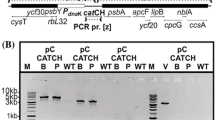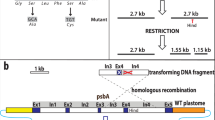Abstract
The work outlines the isolation of transformant Chlamydomonas reinhardtii cells that appear to be unable to repair Photosystem II from photoinhibitory damage. A physiological and biochemical characterization of three mutants is presented. The results show differential stability for the D1 reaction center protein in the three mutants compared to the wild type and suggest lesions that affect different aspects of the Photosystem II repair mechanism. In the ag16.2 mutant, significantly greater amounts of D1 accumulate in the thylakoid membrane than in the wild type under steady-state growth conditions, and D1 loss is significantly retarded in the presence of the protein biosynthesis inhibitor chloramphenicol. Moreover, aberrant electrophoretic mobility of D1 in the ag16.2 suggests that this protein is modified to an as yet unknown configuration. These results indicate that the biosynthesis and/or degradation of D1 is altered in this strain. A different type of mutation occurred in the kn66.7 and kn27.4 mutants of C. reinhardtii. The stability of D1 declined much faster as a function of light intensity in these mutants than in the wild type. Thereby, the threshold of photoinhibition in these mutants was significantly lower than that in the wild type. It appears that kn66.7 and kn27.4 are similar conditional mutants, with the only difference between them being the amplitude of the chloroplast response to the mutation and the differential sensitivity they display to the level of irradiance.
Similar content being viewed by others
References
Adir N, Shochat S and Ohad I (1990) Light-dependent D1 protein synthesis and translocation is regulated by reaction center II: Reaction center II serves as an acceptor for the D1 precursor. J Biol Chem 265: 12563-12568
Arnon D (1949) Copper enzymes in isolated chloroplasts. Polyphenol oxidase in Beta vulgaris. Plant Physiol 24: 1-15
Aro E-M, Virgin I and Andersson B (1993) Photoinhibition of Photosystem II. Inactivation, protein damage and turnover. Biochim Biophys Acta 1143: 113-134
Barber J (1989) Function and molecular biology of Photosystem II. Oxford Surveys of Plant & Cell Biology, Vol 6, pp 115-162
Barber J and Andersson B (1992) Too much of a good thing — light can be bad for photosynthesis. TIBS 17: 61-66
Baroli I and Melis A (1996) Photoinhibition and repair in Dunaliella salinaacclimated to different growth irradiances. Planta 198: 640-646
Callahan FE, Becker DW and Cheniae GM (1986) Studies on the photoinactivation of the water-oxidizing enzyme. II. Characterization of weak light photoinhibition of PS II and its light-induced recovery. Plant Physiol 82: 261-269
Cleland RE, Neale PJ and Melis A (1986) Mechanism of photoinhibition: Photochemical reaction center inactivation in system II of chloroplasts. Photosynth Res 9: 79-88
Davies JP, Yildiz F and Grossman AR (1994) Mutants of Chlamydomonaswith aberrant responses to sulfur deprivation. The Plant Cell 6: 53-63
Davies JP, Yildiz F and Grossman AR (1996) Sac1, a putative regulator that is critical for survival of Chlamydomonas reinhardtiiduring sulfur deprivation. The EMBO J 15: 2150-2159
Demeter S, Neale PJ and Melis A (1987) Photoinhibition: impairment of the primary charge separation between P680 and pheophytin in Photosystem II of chloroplasts. FEBS Lett 214: 370-374.
Duysens LNM, Amesz J and Kamp BM (1961) Two photochemical systems in photosynthesis. Nature 190: 510-511.
Gorman DS and Levine RP (1966) Photosynthetic electron-transport chain of Chlamydomonas reinhardtii. Plant Physiol 41: 1637-1656
Greenberg BM, Gaba V, Mattoo AK and Edelman M (1987) Identification of a primary in vivodegradation product of the rapidly-turning-over 32 kd protein of Photosystem II. EMBO J 6: 2865-2869
Greer DM, Berry JA and Bjorkman O (1986) Photoinhibition of photosynthesis in intact bean leaves: Role of light and temperature, and requirement for chloroplast-encoded protein synthesis during recovery. Planta 168: 253-260
Guenther JE and Melis A (1990) The physiological significance of Photosystem II heterogeneity in chloroplasts. Photosynth Res 23: 105-110
Guenther JE, Nemson JA and Melis A (1990) Development of PS II in dark grown Chlamydomonas reinhardtii. A light-dependent conversion of PS IIβ, QB-nonreducing centers to the PS IIα, QB-reducing form. Photosynth Res 24: 35-46
Harris, EH (1989) The ChlamydomonasSourcebook. A Comprehensive Guide to Biology and Laboratory Use. Academic Press, New York
Hill R and Bendall F (1960) Function of the two cytochrome components in chloroplasts: A working hypothesis. Nature 186: 136-137.
Kautsky H and Hirsch A (1931) Neue versuche zur kohlensäuerassmilation. Naturwissenschaften 48: 964-969
Kim J, Klein PG and Mullet JE (1994) Synthesis and turnover of Photosystem II reaction center protein D1. Ribosome pausing increases during chloroplast development. J Biol Chem 269: 17918-17923
Kim JH, Nemson JA, Melis A (1993) Photosystem II reaction center damage and repair in the green alga Dunaliella salina: Analysis under physiological and adverse irradiance conditions. Plant Physiol 103: 181-189
Kindle KL (1990) High-frequency nuclear transformation of Chlamydomonas reinhardtii. Proc Natl Acad Sci USA 87: 1228-1232
Kitajima M and Butler WL (1975) Quenching of chlorophyll fluorescence and primary photochemistry in chloroplasts by dibromothymoquinone. Biochim Biophys Acta 376: 105-115
Laemmli U (1970) Cleavage of structural proteins during the assembly of the head of bacteriophage T4. Nature 227: 680-685
Mattoo AK, Pick U, Hoffman-Falk H and Edelman M (1981) The rapidly metabolized 32,000-dalton polypeptide of the chloroplast is the ‘proteinaceous shield’ regulating Photosystem II electron transport and mediating diuron herbicide sensitivity. Proc Natl Acad Sci USA 78: 1572-1576
Mattoo A, Hoffman-Falk H, Marder J and Edelman M (1984) Regulation of protein metabolism: Coupling of photosynthetic electron-transport to in vivodegradation of the rapidly metabolized 32-kDa protein of the chloroplast membranes. Proc Natl Acad Sci USA 81: 1380-1384
Mattoo AK and Edelman M (1987) Intramembrane translocation and posttranslational palmitoylation of the chloroplast 32-kDa herbicide-binding protein. Proc Natl Acad Sci USA 84: 1497-1501
Melis A (1989) Spectroscopic methods in photosynthesis: photosystem stoichiometry and chlorophyll antenna size. Phil Trans R Soc London B 323: 397-409
Melis A (1991) Dynamics of photosynthetic membrane composition and function. Biochim Biophys Acta (Reviews on Bioenergetics) 1058: 87-106
Melis A, Spangfort M and Andersson B (1987) Light-absorption and electron-transport balance between PS II and PS I in spinach chloroplasts. Photochem Photobiol 45: 129-136
Ohad I, Kyle DJ and Arntzen CJ (1984) Membrane protein damage and repair: Removal and replacement of inactivated 32-kilodalton polypeptides in chloroplast membranes. J Cell Biol 99: 481-485
Powles SB (1984) Photoinhibition of photosynthesis induced by visible light. Annu Rev Plant Physiol 35: 15-44
Rova M, Franzen LG, Fredriksson PO and Styring S (1994) Photosystem II in a mutant of Chlamydomonas reinhardtiilacking the 23 kD psbPprotein shows increased sensitivity to photoinhibition in the absence of chloride. Photosynth Res 39: 75-83
Schnettger B, Critchly C, Santore UJ, Graf M and Krause GH (1994) Relationship between photoinhibition of photosynthesis, D1 protein turnover and chloroplast structure: Effects of protein synthesis inhibitors. Plant Cell Environ 17: 55-64
Tam L-W and Lefebvre PA (1993) Cloning of flagellar genes in Chlamydomonas reinhardtiiby DNA insertional mutagenesis. Genetics 135: 375-384
Tyystjärvi E and Aro E-M (1996) The rate constant of photoinhibition, measured in lincomycin-treated leaves, is directly proportional to light intensity. Proc Natl Acad Sci USA 93: 2213-2218
Author information
Authors and Affiliations
Rights and permissions
About this article
Cite this article
Zhang, L., Niyogi, K.K., Baroli, I. et al. Dna insertional mutagenesis for the elucidation of a Photosystem II repair process in the green alga Chlamydomonas reinhardtii. Photosynthesis Research 53, 173–184 (1997). https://doi.org/10.1023/A:1005867709441
Issue Date:
DOI: https://doi.org/10.1023/A:1005867709441




